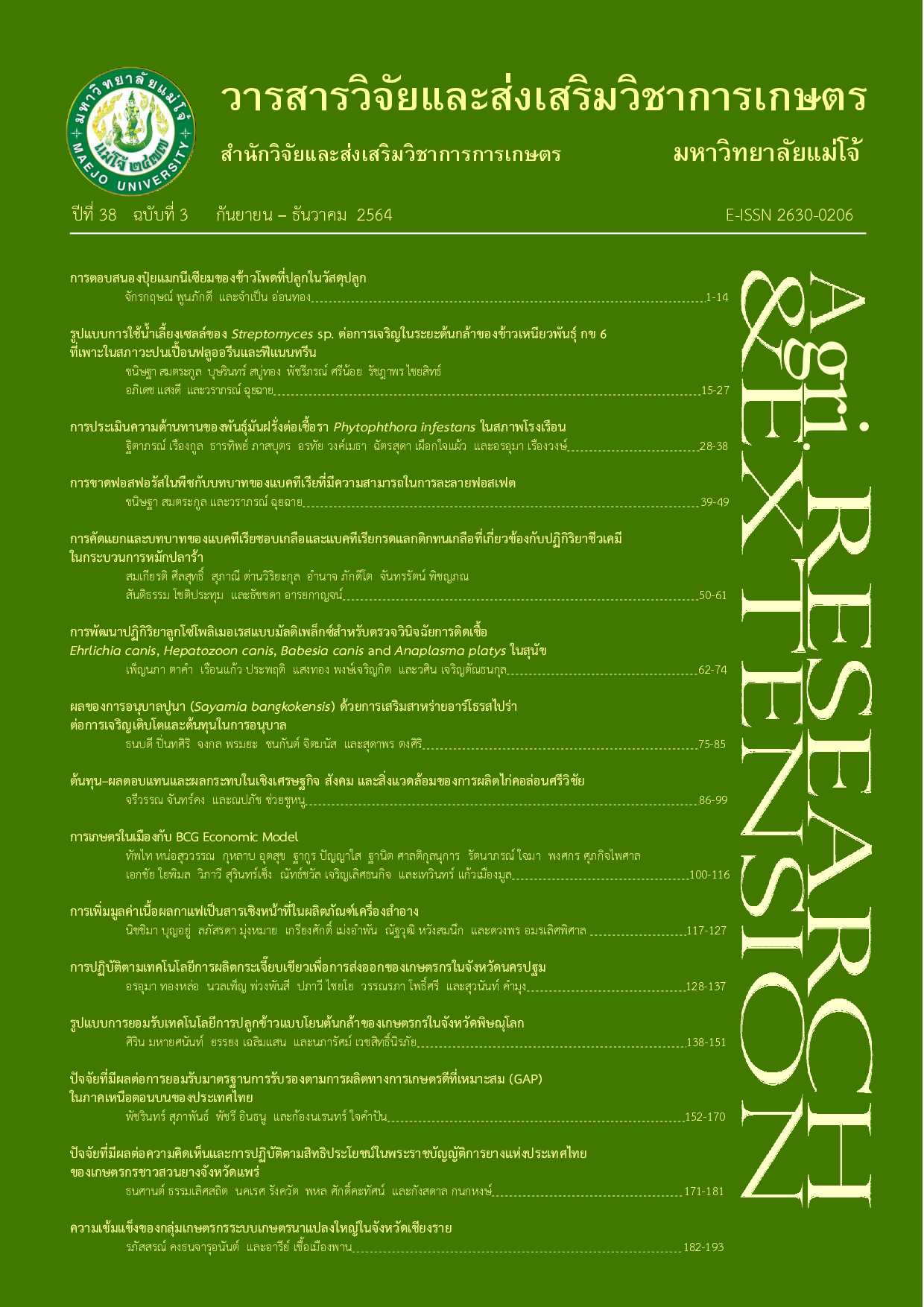การเพิ่มมูลค่าเนื้อผลกาแฟเป็นสารเชิงหน้าที่ในผลิตภัณฑ์เครื่องสำอาง
คำสำคัญ:
เนื้อผลกาแฟ, สารประกอบฟีโนลิก, สารต้านอนุมูลอิสระ, ฤทธิ์ต้านเอมไซม์ไทโรซิเนส, ผลิตภัณฑ์เครื่องสำอางบทคัดย่อ
เนื้อผลกาแฟ (Coffee Pulp; CP) เป็นส่วนเหลือทิ้งจากอุตสาหกรรมการผลิตเมล็ดกาแฟ จัดเป็นเศษเหลือที่ก่อให้เกิดปัญหาทางด้านสิ่งแวดล้อมทั้งคุณภาพดินที่เป็นกรดและกลิ่นไม่พึงประสงค์ การศึกษาครั้งนี้จึงนำ CP สายพันธุ์อราบิก้าที่เป็นวัสดุเหลือทิ้งมาเพิ่มมูลค่าเป็นสารเชิงหน้าที่ในเครื่องสำอางบำรุงผิว โดยนำ CP มาทำการสกัดด้วยน้ำและทำให้แห้งด้วยวิธีแช่เยือกแข็งได้เป็นสารสกัดเนื้อผลกาแฟ (Coffee Pulp Extract; CPE) นำไปวิเคราะห์หาปริมาณสารประกอบฟีโนลิกพบว่า CPE มีฟีนอลิกรวม 45.12 มิลลิกรัมสมมูลกรดแกลลิกต่อ 1 กรัมของสารสกัด โดยมีกรดคลอโรจีนิกซึ่งเป็นสารออกฤทธิ์ทางชีวภาพเท่ากับ 17.8 มก./กก. ในส่วนของการศึกษาฤทธิ์ทางชีวภาพพบว่า CPE มีความสามารถในการยับยั้งอนุมูลอิสระ ABTS, DPPH และ superoxide ได้ร้อยละ 50 (IC50) มีค่าเท่ากับ 0.59, 0.94 และ 9.53 มก./มล. นอกจากนี้ยังพบว่า CPE สามารถยับยั้งเอนไซม์ไทโรซิเนสที่เป็นสาเหตุของการสังเคราะห์เมลานิน มีค่า IC50 เท่ากับ 125.21 มก./มล. จากผลการทดลองดังกล่าวพบว่า CPE มีคุณสมบัติเป็นสารเชิงหน้าที่เพื่อการนำไปใช้ประโยชน์ด้านเครื่องสำอาง จึงนำไปพัฒนาในตำรับครีมบำรุงผิวหน้า และทดสอบความคงตัวของผลิตภัณฑ์ใน 4 สภาวะ ได้แก่ อุณหภูมิห้อง 4°ซ. และ 45°ซ. เป็นเวลา 90 วัน และทดสอบความคงตัวของผลิตภัณฑ์แบบเร่งโดยการทดสอบแบบร้อนสลับเย็นจำนวน 6 รอบ ผลการทดลองพบว่าผลิตภัณฑ์ที่พัฒนาขึ้นมีความคงตัวดีทั้ง 4 สภาวะ ดังนั้น CPE จึงมีศักยภาพในการนำมาเพิ่มมูลค่าเป็นสารเชิงหน้าที่ในผลิตภัณฑ์เครื่องสำอางบำรุงผิว
เอกสารอ้างอิง
Barbulova, A., G. Colucci and F. Apone. 2015. New trends in cosmetics: by-products of plant origin and their potential use as cosmetic active ingredients. Cosmetics 2(2): 82-92.
Bessada, S.M.F., R.C. Alves and M.B.P.P. Oliveira. 2018. Coffee silverskin: a review on potential cosmetic applications. Cosmetics 5(1): 5.
Burger, P., A. Landreau, S. Azoulay, T. Michel and X. Fernandez. 2016. Skin whitening cosmetics: feedback and challenges in the development of natural skin lighteners. Cosmetics 3(4): 36.
Erdem, S.A., F.S. Senol, E. Budakoglu, I.E. Orhan and B. Sener. 2016. Exploring In Vitro neurobiological effects and high–pressure liquid chromatography–assisted quantitation of chlorogenic acid in 18 Turkish coffee brands. J Food Drug Anal. 24(1): 112-120.
Hammerschmidt, P.A. and D.E. Pratt. 1978. Phenolic antioxidants of dried soybeans. J Food Sci 43(2): 556-559.
Kiattisin, K., T. Nantarat and P. Leelapornpisid. 2016. Evaluation of antioxidant and anti–tyrosinase activities as well as stability of green and roasted coffee bean extracts from Coffea arabica and Coffea canephora grown in Thailand. J Pharmacognosy Phytother 8(10): 182-192.
Kiattisin, K., N. Nitthikan, W. Poomanee, P. Leelapornpisid, H. Viernstein and M. Mueller. 2019. Anti-inflammatory, antioxidant activities and safety of Coffea arabica leaf extract for alternative cosmetic ingredient. Chiang Mai J Sci. 46(2): 284-294.
Li, H.R., M. Habasi, L.Z. Xie and H.A. Aisa. 2014. Effect of chlorogenic acid on melanogenesis of B16 melanoma cells. Molecules 19: 12940-12948.
Masuda, T., D. Yamashita, Y. Takeda and S. Yonemori. 2005. Screening for tyrosinase inhibitors among extracts of seashore plants and identification of potent inhibitors from Garcinia subelliptica. Biosci Biotechnol Biochem. 69(1): 197-201.
Mensor, L.L., F.S. Menezes, G.G. Leitão, A.S. Reis, T.C.D. Santos, C.S. Coube and S.G. Leitão. 2001. Screening of Brazilian plant extracts for antioxidant activity by the use of DPPH free radical method. Phytother Res. 15(2): 127-130.
Murthy, P.S. and M.M. Naidu. 2012. Sustainable management of coffee industry by–products and value addition a review. Resour Conserv Recy 66: 45-58.
Naveed, M., V. Hejazi, M. Abbas, A.A. Kamboh, G.J. Khan, M. Shumzaid, F. Ahmad, D. Babazadeh, X. FangFang, F. Modarresi–Ghazani, L. WenHua and Z. XiaoHui. 2018. Chlorogenic acid (CGA): a pharmacological review and call for further research. Biomed Pharmacother 97: 67-74.
Nishikimi, M., N.A. Rao, K. Yagi. 1972. The occurrence of superoxide anion in the reaction of reduced phenazine methosulfate and molecular oxygen. Biochem Biophys Res Commun 46(2): 849-854.
Pandey, A., C.R. Soccol, P. Nigam, D. Brand, R. Mohan and S. Roussos. 2000. Biotechnological potential of coffee pulp and coffee husk for bioprocesses. Biochem Eng. J. 6(2): 153-162.
Plainfossé, H., P. Burger, S. Azoulay, A. Landreau, G. Verger-Dubois and X. Fernandez. 2018. Development of a natural anti–age ingredient based on Quercus pubescens willd. leaves extract a case study. Cosmetics 5(1): 15.
Płotka-Wasylka, J., M. Rutkowska, K. Owczarek, M. Tobiszewski and J. Namiesnik. 2017. Extraction with environmentally friendly solvents. Trends Anal Chem. 91: 12-25.
amirez-Martinez, J.R. 1988. Phenolic compounds in coffee pulp: quantitative determination by HPLC. J Sci Food Agr 43(2): 135-144.
Rathinavelu, R. and Graziosi, G. 2005. Potential alternative use of coffee wastes and by–products. [Online]. Available http://www.ico.org/documents/ed1967e.pdf (4 June 2019).
Re, R., N. Pellegrini, A. Proteggente, A. Pannala, M. Yang and C. Rice-Evans. 1999. Antioxidant activity applying an improved ABTS radical cation decolorization assay. Free Radic Biol Med. 26(9-10): 1231-1237.
Ribeiro, A.S., M. Estanqueiro, M.B. Oliveira and J.M.S. Lobo. 2015. Main benefits and applicability of plant extracts in skin care products. Cosmetics 2(2): 48-65.
Rodriguez de Sotillo, D.V. and M. Hadley. 2002. Chlorogenic acid modifies plasma and liver concentrations of cholesterol, triacylglycerol, and minerals in (fa/fa) Zucker rats. J Nutr Biochem. 13(12): 717-726.
Soto, M.L., E. Falqué and H. Domínguez. 2015. Relevance of natural phenolics from grape and derivative products in the formulation of cosmetics. Cosmetics 2(3): 259-276.
Uwa, L.M. 2017. The anti-aging efficacy of antioxidants. Curr Trends Biomedical Eng & Biosci 7(4): 2-4.
Whangsomnuek, N., L. Mungmai, K. Mengamphanand D. Amornlerdpison. 2019. Efficiency of skin whitening cream containing Etlingera elatior flower and leaf extracts in volunteers. Cosmetics 6(3): 39.
Zillich, O.V., U. Schweiggert-Weisz, P. Eisner and M. Kerscher. 2015. Polyphenols as active ingredients for cosmetic products. Int J Cosmetic Sci. 37: 455-464.
ดาวน์โหลด
เผยแพร่แล้ว
รูปแบบการอ้างอิง
ฉบับ
ประเภทบทความ
สัญญาอนุญาต
บทความนี้ได้รับการเผยแพร่ภายใต้สัญญาอนุญาต Creative Commons Attribution-NonCommercial-NoDerivatives 4.0 International (CC BY-NC-ND 4.0) ซึ่งอนุญาตให้ผู้อื่นสามารถแชร์บทความได้โดยให้เครดิตผู้เขียนและห้ามนำไปใช้เพื่อการค้าหรือดัดแปลง หากต้องการใช้งานซ้ำในลักษณะอื่น ๆ หรือการเผยแพร่ซ้ำ จำเป็นต้องได้รับอนุญาตจากวารสาร





